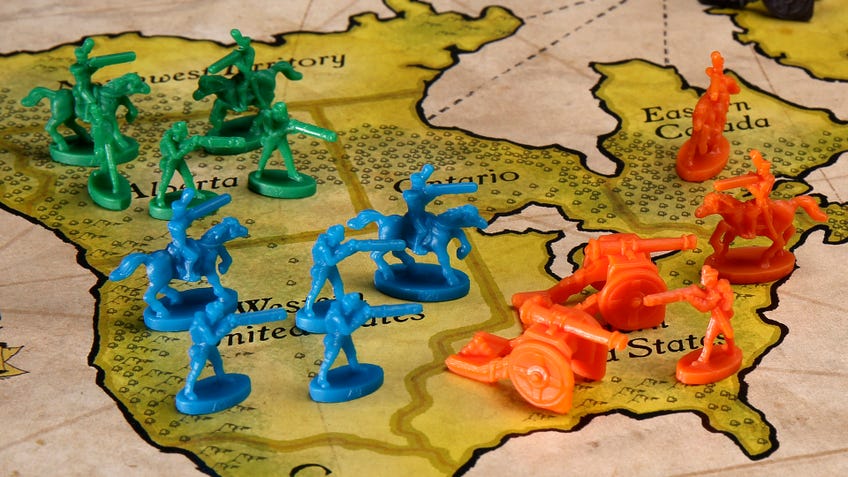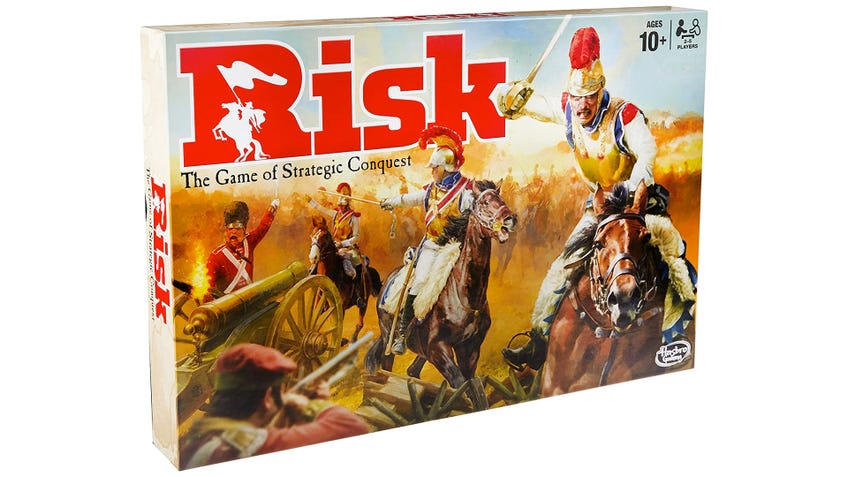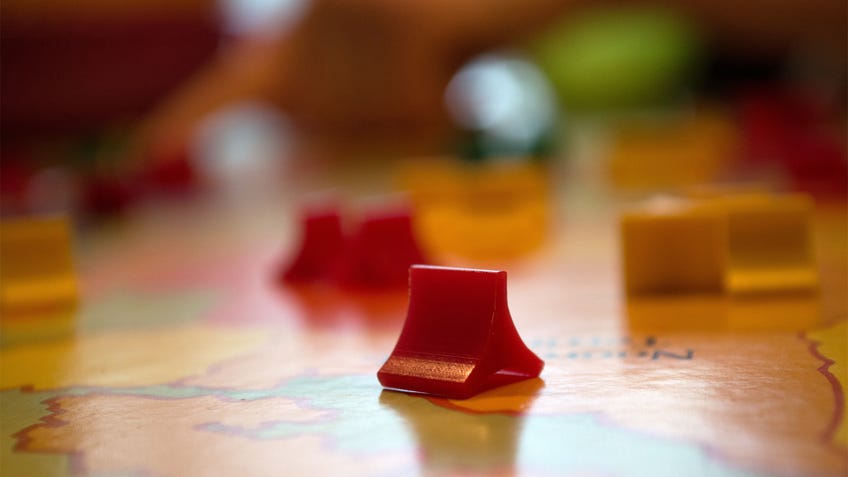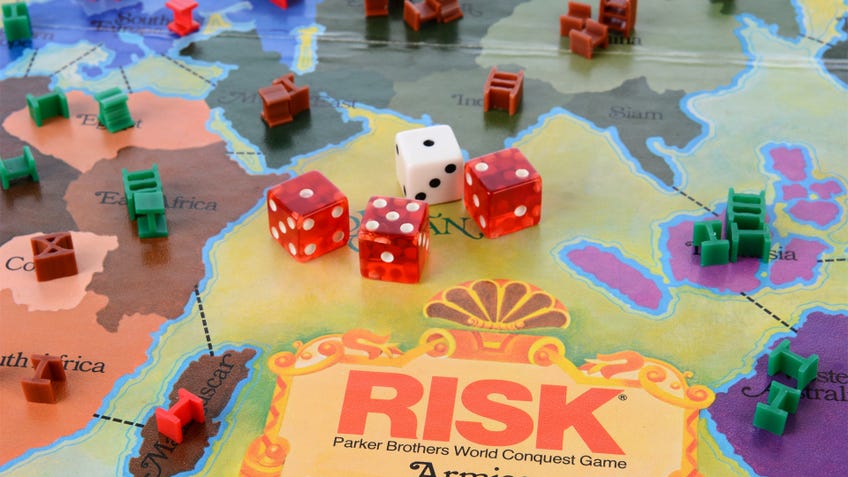How to play Risk: board game’s rules, setup and how to win
Get a recap of the classic strategy game’s rules.
Risk is one of the most famous board games of all time. Invented in the late 1950s by French filmmaker Albert Lamorisse, the strategy game of battling armies and global domination has become a true tabletop classic, inspiring various spin-offs, editions and even spawning the legacy game genre. Even so, the classic rules have remained largely untouched for the last 70 years - so learning how to play Risk is as simple as it was decades ago.
How to play Risk board game
- What do you do in the Risk board game?
- How many people can play Risk?
- How long does Risk take to play?
- How to set up Risk
- How to play Risk
- How to win Risk
- How to play Risk with two players
- Risk Secret Mission rules
The rules of Risk ultimately boil down to a simple game of dice-rolling combat, as players move their armies around the board before engaging in battles determined by the roll of the die. Even so, there are a number of specific rules you should know before diving in, to ensure that things are kept fair and you’re able to enjoy the board game as it was intended.
Here we’ll be running through the original rules for Risk, rather than those of its many editions based on popular films or that relocate the board game’s battles to the distant future.
What do you do in the Risk board game?
In Risk, players are competing to achieve world domination by eliminating their opponents. Players strengthen their occupied territories - representing regions around the globe - by adding additional troops, before rolling dice to attack and capture neighbouring territories.
How many people can play Risk?
Up to six people can play classic Risk. The standard game also includes a rules variant to support just two players. Some of the board game’s other editions have varying player counts, but typically support from two to four players.
How long does Risk take to play?
The amount of time needed to play Risk can vary greatly depending on players’ dice rolls and decisions around the table. The game can play in as little as one hour, or can last for up to eight hours - or more! - depending on the number of players and what they roll.
How to set up Risk
To set up Risk, each player should begin by choosing a colour to play. Depending on the number of players, each player will have a different number of infantry pieces (also called armies):
- Two players: 40 infantry (see How to play Risk with two players)
- Three players: 35 infantry
- Four players: 30 infantry
- Five players: 25 infantry
- Six players: 20 infantry
(Infantry pieces can be traded at any time for cavalry or artillery pieces. Cavalry pieces are worth 5 infantry. Artillery are worth 10 infantry, or 2 cavalry.)
Place the board on the table. Each player should roll a die. The player who rolls highest should place one infantry piece on any territory. Then, the person on their left places a piece on any unoccupied territory.
This repeats until all 42 territories on the board have been claimed. Once all the territories are claimed, players can add additional pieces to their territories until all players’ pieces have been placed. There is no limit to the number of pieces that can occupy one territory.
Remove the secret mission cards from the deck. Shuffle the deck of Risk cards. Place the shuffled pile facedown next to the board, forming the draw pile. You’re ready to play!

How to play Risk
Starting with the player who rolled highest during setup, followed by the player on their left and going clockwise around the table, players perform three steps on their turn: placing new armies, attacking and fortifying.
Placing armies
Each player starts their turn by working out how many armies they can add to their territories on the board. This is calculated in the following way:
Count the number of territories you occupy, divide by three and round down. For example, if you occupy 11 territories you will receive three armies. A player will always be able to place at least three armies, even if they occupy fewer than three territories.
For each continent a player controls - by occupying every territory at the start by their turn - they receive a specific number of armies (also listed in the bottom-left corner of the board or next to each continent, depending on your edition):
- Africa: 3
- Asia: 7
- Australia: 2
- Europe: 5
- North America: 5
- South America: 2
Players can trade sets of Risk cards to receive extra armies. If you have five or six cards at the start of your turn, you MUST trade in at least one set, with the chance to trade twice; if you have fewer cards, it is optional.
To trade cards, you must trade three cards that all show the same infantry, cavalry or artillery icon; three cards that have one of each icon (infantry, cavalry, artillery); or two matching cards plus a wild card (wild cards show all three icons).
Players receive a number of armies based on the number of sets traded by all of the players so far (Tip: place traded sets under the edge of the board to help keep count!):
- First set: 4 armies
- Second set: 6 armies
- Third set: 8 armies
- Fourth set: 10 armies
- Fifth set: 12 armies
- Sixth set: 15 armies
After the sixth set, each set of cards receives five more armies than the previous set. For example, the seventh set would receive 20 armies, the eighth set 25 and so on.
If at least one of the cards traded in a set shows a territory that you occupy, you also receive two additional armies - they must be placed on that region. You cannot receive more than two bonus armies for matching territories in a single set, even if multiple cards match your territories.

Attacking
Once a player has placed their armies, they may choose to attack. This step is optional; a player can choose only to place armies and fortify.
A player can choose to attack an adjacent enemy territory that shares a border with a territory they occupy, or one connected by a dashed line - representing a naval attack. In order to attack, a player must have at least two infantry pieces in their territory.
The player should declare which territory they are attacking, and where they are attacking from. Then, the attacking player and the defending player both decide how many dice they will roll.
The attacker can choose to roll one, two or three dice. You must have at least one more army piece than the number of dice you roll (for example, to roll two dice you need at least three armies).
The defender can roll one or two dice. To roll two dice, they must have at least two infantry pieces in the defending territory.
The players should announce how many dice they are rolling at the same time. More dice increases the chance of victory, but also increases losses on a failed roll.
Once they have declared the number of dice they will roll, both players should roll the dice at the same time.

The highest single die value from each player should be compared. If the attacker has a higher value, the defender loses a piece; if the defender rolls higher, the attacker removes an army. The defender always wins ties. This is repeated for each die, from highest to lowest.
If any defending pieces remain once all dice are compared, the attacker can choose to continue attacking the same territory or a different region by repeating the above steps. A player can attack as many territories as many times as they like on their turn, as long as they have enough armies to attack with.
If all of a defender’s pieces are removed, the attacker must capture the territory. To capture a territory, they move some of their attacking troops into the region. This number must be equal to or greater than the number of dice they rolled in the final battle. For example, if you attacked with two dice you must move two infantry into the captured territory. At least one piece must be left in the territory from which you attacked. (Every territory must be occupied by at least one infantry during the game.)
If a player successfully captures at least one territory on their turn, they draw one Risk card from the deck. This can be traded for additional armies on future turns. Only one Risk card is drawn per turn, no matter how many territories were captured.
If you remove a player’s last piece from the board by winning a battle, that player is eliminated. The victorious player adds any Risk cards that the eliminated player was holding to their hand. If this means you have six or more cards in your hand, you must immediately trade in enough sets and place armies to reduce your hand size to under five cards.

Fortify
Whether you attack or not, the active player can end their turn by fortifying.
To fortify, the player can move any number of armies from one territory into an adjacent territory. This can only be performed once per turn, between two adjacent territories - effectively acting like a free move. As with capturing territories, at least one piece must be left behind in the territory being moved from.
How to win Risk
To win Risk, you must eliminate all the other players. This is achieved by capturing all 42 of the territories on the board.
When a player’s last piece is removed from the board as the result of a battle, they are eliminated from the game.

How to play Risk with two players
To play Risk with two players, you must make a number of changes to the regular rules for setup and gameplay.
During setup, each player should take 40 infantry pieces in the colour of their choice. Then, the players select a third colour to serve as a ‘neutral’ player - set aside 40 infantry in the neutral colour.
To determine starting territories, remove the Secret Mission and wild cards from the Risk deck. Shuffle the deck and deal cards facedown into three equal piles. Each player should choose a pile, leaving the last for the neutral player.
Each player should place one of their armies into each of the 14 territories in their card pile. Place a neutral infantry piece in each of the territories listed in the neutral player’s pile. Each player then adds an additional two infantry in their colour to the board - in the same territory, or two separate regions.
Each player then places one additional infantry for the neutral player to a territory it controls - as each player adds one neutral piece, they can use this to help block their opponent.
With all the pieces placed, add the wild cards back to the deck and reshuffle all the cards together to form the deck at the side of the board, as usual.
During gameplay, when a player attacks a neutral territory, the other human player rolls to defend. The neutral player will not attack or add additional pieces.
The game is won by eliminating your human opponent - neutral territories do not count directly towards victory.
Risk Secret Mission rules
Using Risk’s Secret Mission rules, players can win the game by completing their secret mission.
During setup, before territory cards are dealt to the players, each player is dealt a secret mission card facedown.
This mission card determines their secret victory condition. Victory conditions can include controlling a specific number of territories, controlling specific continents and eliminating a certain player colour. (Cards targeting player colours not in use are removed from the secret mission deck before being dealt.) Each card specifies how to win.
In the official rules, a player who successfully completes their secret mission immediately wins at the end of their turn.


